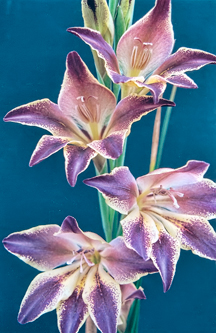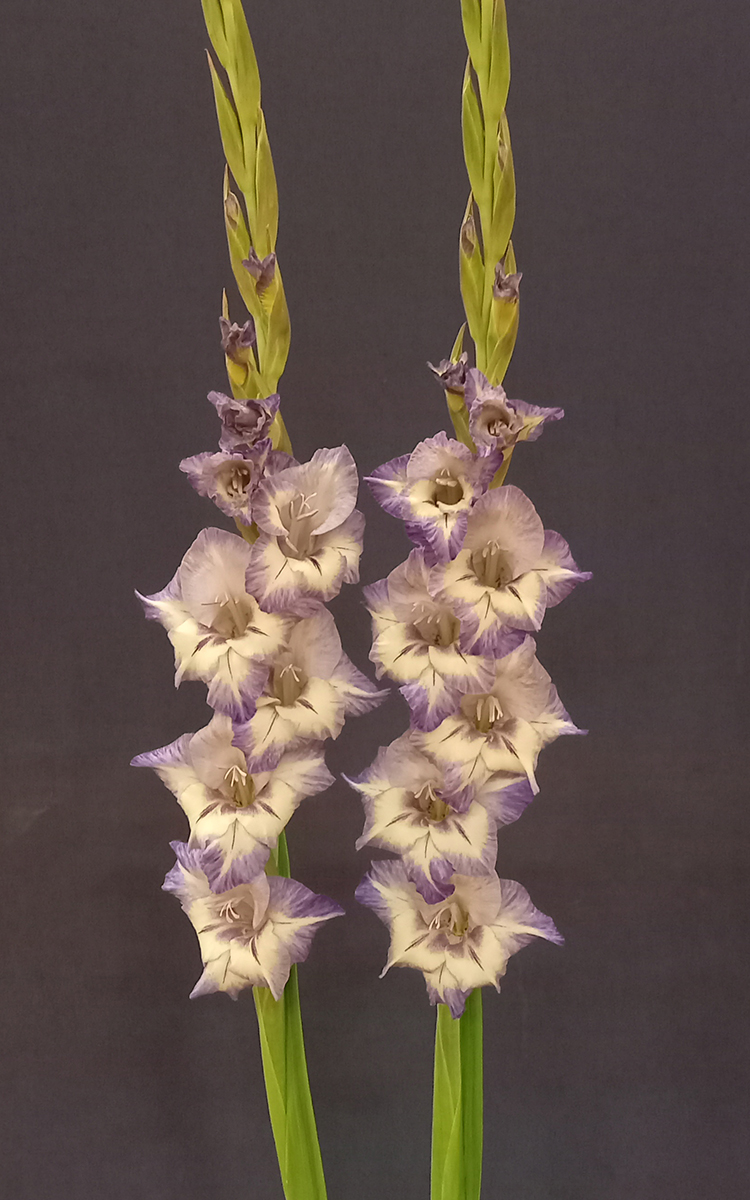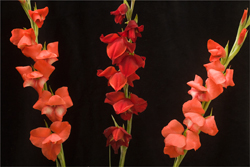 Mr Fawcett President of the British Gladiolus Society and Cormlet officer has asked members to send in their spare cormlets to help with the society funds. You can send them to Trevor Fawcett his address is 197, Aston Clinton Road, Aylesbury, Bucks, HP22 5AD.
Mr Fawcett President of the British Gladiolus Society and Cormlet officer has asked members to send in their spare cormlets to help with the society funds. You can send them to Trevor Fawcett his address is 197, Aston Clinton Road, Aylesbury, Bucks, HP22 5AD.The British Gladiolus Society aims to promote and improve all aspects of Gladiolus culture. Anyone interested in joining the Society should contact the membership Secretary Mr M P.Jones 454 Baker Street, Enfield Middlesex EN1 3QT enclosing a stamped ,self addressed envelope.
Simple Advice for the Beginner.
The first step that most beginners take on the long and happy road of growing gladioli is to either see them waving gracefully in a neighbouring garden or showing themselves off to perfection on the show bench,bolt upright and ready for inspection like ranks of wellturned out soldiers.Having had the corms planted they start to prepare to grow some themselves but often find themselves struggling for advice through lack of literature on the subject or the absence of local growers who can offer advice . That is why you should join the British Gladiolus Society.
 The South African species were originally pollinated by long-tongued anthrophorine bees, but some changes in the pollination system have occurred, allowing pollination by sunbirds, noctuid and Hawk-moths, long-tongued flies and several others. In the temperate zones of Europe many of the hybrid large flowering sorts of gladiolus can be pollinated by small well-known wasps. Actually, they are not very good pollinators because of the large flowers of the plants and the small size of the wasps. Another insect in this zone which can try some of the nectar of the gladioli is the best-known European Hawk-moth Macroglossum stellatarum which usually pollinates many popular garden flowers like Petunia, Zinnia, Dianthus and others.
The South African species were originally pollinated by long-tongued anthrophorine bees, but some changes in the pollination system have occurred, allowing pollination by sunbirds, noctuid and Hawk-moths, long-tongued flies and several others. In the temperate zones of Europe many of the hybrid large flowering sorts of gladiolus can be pollinated by small well-known wasps. Actually, they are not very good pollinators because of the large flowers of the plants and the small size of the wasps. Another insect in this zone which can try some of the nectar of the gladioli is the best-known European Hawk-moth Macroglossum stellatarum which usually pollinates many popular garden flowers like Petunia, Zinnia, Dianthus and others. Any of about 300 species of flowering plants of the genus Gladiolus, in the iris family, native to Europe, Africa, and the Mediterranean and widely cultivated for cut flowers. The flowering spike, which springs from a corm, reaches 2?3 ft (60?90 cm) in height and has many funnel-shaped flowers, all clustered on one side of the stem. There are six petal-like floral parts and sparse, swordlike leaves. Cultivated gladioli, which come in all colours, have been developed mostly from southern and eastern African species.
Gardeners tend to have a love/hate relationship with gladiolus; very few people sit on the fence. If you're reading this, you probably appreciate the intricate beauty of these dramatic flowers and enjoy the vast color selection. Gladiolus hybridizing is a hot area in the horticulture world right now, with breathtaking results. The outstanding choices are popping up so fast we'te having trouble keeping up with good photographs but can't wait to grow dozens of varieties in the near future for just that purpose. No longer the predictable flowers your grandmother grew, glads have morphed into stylish contributors for both gardens and bouquets. Here's to experimenting with zippy new choices!
The British Gladiolus Society is an international society whose aims are to promote interest in the cultivation, breeding and improvement of the gladiolus. Gladioli are very popular, being both beautiful and colourful. They are easily grown in the garden in the borders, or used for cut flowers for the house. They also make excellent exhibition flowers, perhaps starting off at a local show and eventually taking part in the major shows.
As with the rest of this site, clicking on the thumb-nail images located in the gallery will take you to a larger version. Use the Side Navigation to view the show gallery this will be expanded after each show
For last season's images use the side nav bar and click archives > 2011 season. This image intensive web site is best viewed with a monitor resolution set to 1024 X 768 or higher we advise downloading the latest versions of
Internet Explorer, Firefox or Opera browsers for PC; Safari
or Mozilla browsers for Mac. JavaScript is used throughout this site but the navigation menus are in CSS - it is therefore recommended you have JavaScript enabled in your browser.
A broadband connection is also recommended. If you grow Gladiolus for exhibition, cutting, flower arranging or home decoration, then you must join the British Gladiolus Society. Read more → on submitting Photos for your website. Participating in flower shows is a good way to learn more about gladiolus and to meet people with similar interests. Additionally, exhibiting the result of one's gardening efforts can be very gratifying. the British Gladiolus Society hold shows during the summer.
Spikes destined for exhibition The B.G.S. Book Library is quite unique in the selection of books held on Gladioli. There is a wealth of information available to members, and anyone who gives talks of lectures on the subject will find plenty of interesting
facts on the history of the species (from Roman times to present day) scientific data, uses (medicinal and culinary) cultivation, innovations, exhibitions and arranging. Several of the more modern ideas and techniques are really
revamped from times gone by and results of such methods have been recorded within the pages of several publications. Some of the older books also have beautiful colour plates illustrating the printer’s art of years ago.

Mission
Navigation

Hyperlinks are underlined and change colour when your mouse hovers over them click while hovering will activate the link and your will be transfered to another page.Become a member
 This international society was founded in 1926, its objectives are to stimulate interest and promote cultivation, breeding and improvement of the Gladiolus. To issue publications concerning Gladiolus and other items of interest to Gladiolus growers, and to encourage worthy new cultivars and to preserve older ones. To regulate the nomeculture, classification and registration of Gladioli and to hold exhibitions of the flower and to co-operate with other organisations pursuing the same objectives.
Members benefit from the advice and experience of successful growers both in the United Kingdom and abroad.
This international society was founded in 1926, its objectives are to stimulate interest and promote cultivation, breeding and improvement of the Gladiolus. To issue publications concerning Gladiolus and other items of interest to Gladiolus growers, and to encourage worthy new cultivars and to preserve older ones. To regulate the nomeculture, classification and registration of Gladioli and to hold exhibitions of the flower and to co-operate with other organisations pursuing the same objectives.
Members benefit from the advice and experience of successful growers both in the United Kingdom and abroad.
Members receive a free copy of the Gladiolus Annual, which is a comprehensive yearly publication distributed worldwide to individuals, institutes and affiliated societies.
Three Newsletter bulletins per year, free admission to exhibitions where this can be arranged and the right to exhibit at all society exhibitions.
Members may use the society book and transparency library and receive free advice on all aspects of Gladiolus culture.
join → on submitting our form.Exhibiting gladioli
 should have florets with petals that are fully hydrated and show no sign of aging or insect damage. Choose spikes that have the bottom one-third or their florets in full bloom, the middle one-third showing color
and the upper one-third in bud. Florets should be evenly spaced and all facing in the same direction. The stem should be straight and the tip of the spike should not be bent. Cut the spike so that the stem portion is about one-third its total length.
It is best to cut spikes for exhibition the night before the show, place them in water and allow them to remain overnight in a cool location for florets to gain maximum hydration.
should have florets with petals that are fully hydrated and show no sign of aging or insect damage. Choose spikes that have the bottom one-third or their florets in full bloom, the middle one-third showing color
and the upper one-third in bud. Florets should be evenly spaced and all facing in the same direction. The stem should be straight and the tip of the spike should not be bent. Cut the spike so that the stem portion is about one-third its total length.
It is best to cut spikes for exhibition the night before the show, place them in water and allow them to remain overnight in a cool location for florets to gain maximum hydration.


